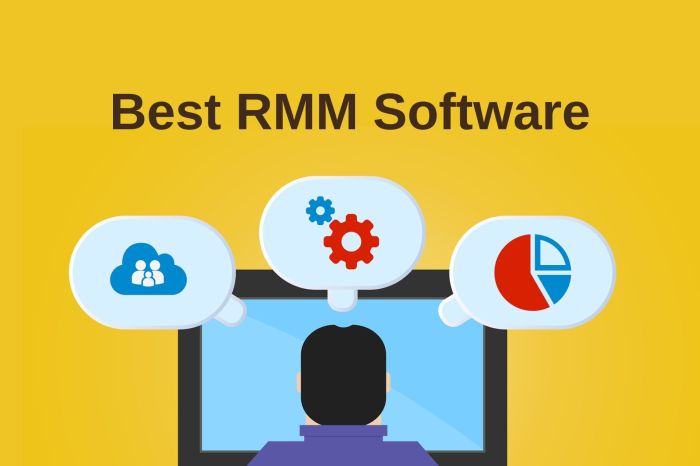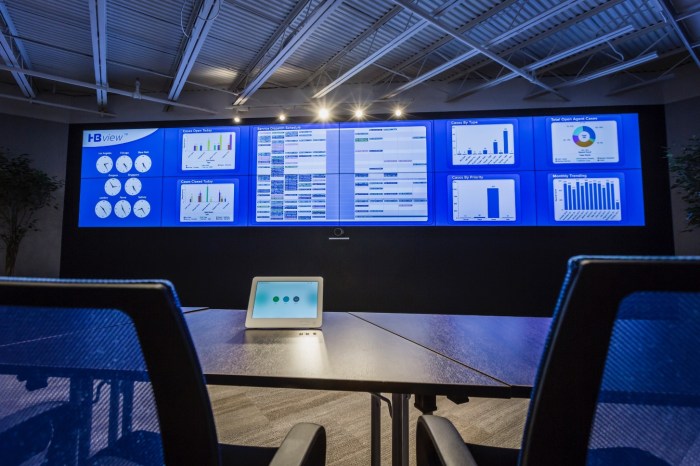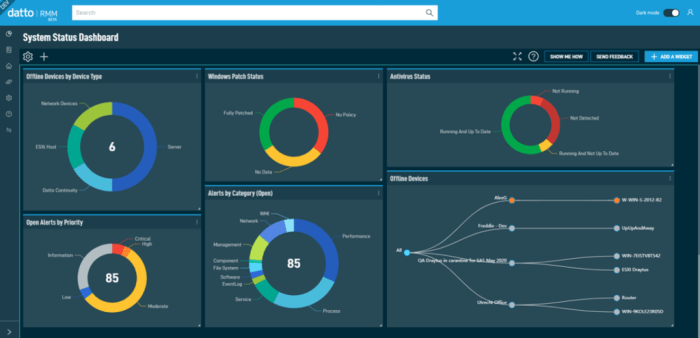Embark on a journey to conquer the complexities of IT infrastructure with our comprehensive guide, Taming the IT Beast: A Guide to the Top Remote Monitoring and Management (RMM) Solutions. In this digital era, managing IT remotely is no longer a choice but a necessity.
Join us as we explore the intricacies of RMM solutions, empowering you to harness their potential and tame the challenges of remote IT management.
Delve into the essential features, compare leading RMM solutions, and uncover the secrets of successful deployment and implementation. Discover real-world use cases, address security considerations, and stay abreast of emerging trends shaping the future of IT management. Let us guide you towards choosing the perfect RMM solution for your business and unlock the full potential of effective RMM implementation.
Introduction to Remote Monitoring and Management (RMM)

Remote Monitoring and Management (RMM) refers to the practice of monitoring and managing IT infrastructure and devices remotely, typically over a network or the internet.
RMM solutions provide a centralized platform for IT administrators to remotely access, monitor, and manage devices, such as servers, desktops, laptops, and network devices, from a single location. This enables them to proactively identify and resolve issues, perform maintenance tasks, and ensure optimal performance and security of IT systems.
Benefits of RMM
- Improved Efficiency:RMM automates many IT management tasks, freeing up IT staff to focus on more strategic initiatives.
- Reduced Downtime:RMM enables proactive monitoring and maintenance, reducing the likelihood of unplanned downtime and disruptions.
- Increased Security:RMM solutions provide real-time monitoring for security threats, allowing IT teams to quickly detect and respond to potential breaches.
- Cost Savings:RMM can help reduce IT costs by eliminating the need for on-site visits and reducing the need for additional IT staff.
Challenges of Managing IT Infrastructure Remotely
- Network Connectivity:Remote management requires reliable network connectivity to ensure access to devices.
- Security Concerns:Remote access introduces potential security risks, such as unauthorized access or data breaches.
- Limited Control:Remote management may not provide the same level of control as on-site management, especially for complex or sensitive tasks.
- User Resistance:Users may be resistant to remote management due to concerns about privacy or disruption to their work.
Key Features of RMM Solutions
RMM solutions offer a comprehensive suite of features that enable IT professionals to remotely manage and monitor their IT infrastructure. These features can be broadly categorized into the following groups:
Essential features of RMM solutions include:
- Remote monitoring:RMM solutions allow IT professionals to monitor the health and performance of their IT infrastructure from a central location. This includes monitoring servers, workstations, network devices, and applications.
- Remote management:RMM solutions allow IT professionals to remotely manage their IT infrastructure. This includes tasks such as software deployment, patch management, and security updates.
- Alerting and reporting:RMM solutions can generate alerts and reports based on the data collected from the monitored systems. This allows IT professionals to identify and resolve issues before they become major problems.
- Patch management:RMM solutions can automate the process of patching software and operating systems. This helps to ensure that systems are up-to-date with the latest security patches.
- Security management:RMM solutions can help to protect IT infrastructure from security threats. This includes features such as antivirus and malware protection, intrusion detection, and firewall management.
In addition to these essential features, RMM solutions may also offer a variety of other features, such as:
- Asset management:RMM solutions can help to track and manage IT assets. This includes hardware, software, and licenses.
- Backup and recovery:RMM solutions can help to back up and recover data in the event of a system failure.
- Help desk integration:RMM solutions can integrate with help desk software to provide a single pane of glass for managing IT support.
The specific features offered by RMM solutions vary from provider to provider. Some of the most popular RMM solutions include:
- SolarWinds MSP Remote Monitoring & Management:SolarWinds MSP Remote Monitoring & Management is a comprehensive RMM solution that offers a wide range of features, including remote monitoring, remote management, alerting and reporting, patch management, and security management.
- N-able N-central:N-able N-central is another popular RMM solution that offers a similar range of features to SolarWinds MSP Remote Monitoring & Management.
- Datto RMM:Datto RMM is a cloud-based RMM solution that is designed for small and medium-sized businesses. Datto RMM offers a range of features, including remote monitoring, remote management, alerting and reporting, and patch management.
Comparison of Top RMM Solutions

Remote Monitoring and Management (RMM) solutions provide a centralized platform for IT teams to monitor, manage, and secure their IT infrastructure remotely. Choosing the right RMM solution is crucial for businesses looking to improve their IT efficiency and reduce downtime.
Here’s a comparison of the top RMM solutions based on their features, pricing, and customer support:
Features
| Feature | Atera | Datto RMM | SolarWinds RMM | N-central |
|---|---|---|---|---|
| Remote Monitoring | Yes | Yes | Yes | Yes |
| Patch Management | Yes | Yes | Yes | Yes |
| Antivirus/Anti-Malware | Yes | Yes | Yes | Yes |
| Backup and Disaster Recovery | Yes | Yes | Yes | Yes |
| Remote Control | Yes | Yes | Yes | Yes |
| Scripting and Automation | Yes | Yes | Yes | Yes |
| Mobile App | Yes | Yes | Yes | Yes |
Pricing, Taming the IT Beast: A guide to the top Remote Monitoring and Management (RMM) Solutions
| Pricing Model | Atera | Datto RMM | SolarWinds RMM | N-central |
|---|---|---|---|---|
| Per Device | $79/month | $129/month | $149/month | $169/month |
| Per Technician | $199/month | $299/month | $349/month | $399/month |
Customer Support
- Atera: 24/7 phone, email, and chat support
- Datto RMM: 24/7 phone, email, and chat support
- SolarWinds RMM: 24/7 phone, email, and chat support
- N-central: 24/7 phone, email, and chat support
Strengths and Weaknesses:
- Atera:Strengths: Affordable, easy to use, good customer support. Weaknesses: Limited features compared to other solutions.
- Datto RMM:Strengths: Comprehensive feature set, reliable, strong customer support. Weaknesses: Expensive.
- SolarWinds RMM:Strengths: Powerful scripting and automation capabilities, good value for money. Weaknesses: Can be complex to use.
- N-central:Strengths: Advanced features, customizable, good customer support. Weaknesses: Expensive.
Deployment and Implementation of RMM Solutions: Taming The IT Beast: A Guide To The Top Remote Monitoring And Management (RMM) Solutions

Deploying and implementing RMM solutions requires careful planning and execution to ensure a smooth and successful implementation. The following steps provide a comprehensive guide:
- Planning:Determine the scope of the implementation, including the devices and systems to be managed, and define the desired outcomes.
- Agent Deployment:Install the RMM agent on all target devices. This can be done manually or through automated deployment tools.
- Configuration:Configure the RMM solution to meet the specific requirements of the organization, including setting up monitoring parameters, alerts, and reporting.
- Testing:Conduct thorough testing to verify that the RMM solution is functioning correctly and meeting the defined objectives.
- Training:Provide training to the IT team on how to use the RMM solution effectively.
- Ongoing Monitoring:Regularly monitor the RMM solution to ensure it is operating optimally and address any issues promptly.
Best Practices for Ensuring a Smooth and Successful Implementation
- Phased Approach:Implement the RMM solution in phases to minimize disruption and allow for adjustments as needed.
- Communication:Communicate the implementation plan to stakeholders and keep them informed of progress.
- Change Management:Follow established change management procedures to ensure a smooth transition.
- Vendor Support:Utilize vendor support resources to assist with implementation and troubleshooting.
- Continuous Improvement:Regularly review and improve the RMM implementation to optimize performance and meet evolving needs.
Use Cases and Applications of RMM Solutions
RMM solutions are widely adopted by businesses across various industries to streamline IT operations, enhance security, and improve overall efficiency. Here are some real-world examples:
In the healthcare sector, RMM solutions enable remote monitoring and management of medical devices, ensuring optimal performance and reducing downtime. For instance, the University of California, San Francisco (UCSF) Medical Center uses an RMM solution to remotely monitor and manage over 10,000 medical devices, resulting in a significant reduction in device downtime and improved patient care.
In the manufacturing industry, RMM solutions are used to monitor and manage production equipment, reducing downtime and increasing efficiency. For example, a leading automotive manufacturer uses an RMM solution to monitor and manage over 1,000 machines, resulting in a 20% reduction in unplanned downtime and a 5% increase in production output.
In the financial sector, RMM solutions are used to monitor and manage critical IT infrastructure, ensuring high availability and security. For instance, a global investment bank uses an RMM solution to monitor and manage its trading systems, resulting in a 99.99% uptime rate and reduced security risks.
While RMM solutions offer numerous benefits, there are also challenges to consider. These include the cost of implementation, the need for skilled IT staff to manage the solution, and potential security risks if not implemented properly. However, with careful planning and implementation, businesses can overcome these challenges and realize the full benefits of RMM solutions.
Security Considerations for RMM Solutions

Remote Monitoring and Management (RMM) solutions provide numerous benefits for IT infrastructure management. However, it’s crucial to be aware of the potential security risks associated with their use. RMM solutions grant remote access to IT systems, which can create vulnerabilities if not implemented and managed securely.
To mitigate these risks and ensure the security of IT infrastructure, it’s essential to implement robust security measures. These include:
Authentication and Authorization
- Implement strong authentication mechanisms, such as multi-factor authentication (MFA), to prevent unauthorized access.
- Enforce role-based access control (RBAC) to restrict access to sensitive data and functionality based on user roles and permissions.
Encryption
- Encrypt all data transmitted between the RMM agent and the management console to protect it from eavesdropping and interception.
- Use encryption at rest to protect sensitive data stored on the RMM server.
Network Security
- Configure firewalls and intrusion detection/prevention systems (IDS/IPS) to protect the RMM server and agents from unauthorized access and attacks.
- Segment the network to isolate the RMM infrastructure from other parts of the IT network.
Vulnerability Management
- Regularly scan RMM components for vulnerabilities and apply security patches promptly.
- Monitor RMM logs for suspicious activity and investigate any anomalies.
Incident Response
- Develop an incident response plan that Artikels the steps to take in case of a security breach.
- Conduct regular security audits to identify and address any weaknesses in the RMM implementation.
By implementing these security measures, organizations can mitigate the risks associated with RMM solutions and ensure the security of their IT infrastructure.
Integration with Other IT Tools
Integrating RMM solutions with other IT tools is crucial for streamlining IT operations and enhancing overall efficiency. By connecting RMM solutions with specialized tools, IT teams can gain a comprehensive view of their IT infrastructure, automate tasks, and respond to issues proactively.
RMM solutions can integrate with various IT tools, including ticketing systems, antivirus software, network monitoring tools, and cloud management platforms. This integration enables seamless data exchange and allows IT teams to manage multiple aspects of their IT environment from a centralized platform.
Ticketing Systems
Integrating RMM solutions with ticketing systems automates ticket creation and assignment based on alerts generated by the RMM. This eliminates the need for manual ticket creation and ensures that issues are addressed promptly. It also provides a complete audit trail for tracking ticket resolution and response times.
Antivirus Software
Integrating RMM solutions with antivirus software enables centralized management of antivirus updates, scans, and threat detection. This integration allows IT teams to remotely deploy antivirus updates, schedule scans, and receive notifications of potential threats. It enhances the overall security posture of the IT environment by ensuring that all endpoints are protected against malware and other cyber threats.
Emerging Trends in RMM Solutions
The Remote Monitoring and Management (RMM) landscape is constantly evolving, with new trends and advancements emerging all the time. These trends are shaping the future of IT management, making it more efficient, effective, and secure.
One of the most significant trends in RMM is the increasing use of artificial intelligence (AI) and machine learning (ML). AI-powered RMM tools can automate many of the tasks that are traditionally performed by IT administrators, such as monitoring system performance, detecting and resolving issues, and patching software.
This can free up IT staff to focus on more strategic initiatives.
Another key trend is the convergence of RMM and endpoint security solutions. This is due to the fact that endpoints are increasingly becoming the target of cyberattacks. By integrating RMM and endpoint security, organizations can gain a more comprehensive view of their IT environment and better protect against threats.
Finally, there is a growing trend towards cloud-based RMM solutions. Cloud-based RMM tools offer several advantages over on-premises solutions, including scalability, flexibility, and ease of use. This makes them a good option for organizations of all sizes.
Adoption of AI and ML
- AI-powered RMM tools can automate many of the tasks that are traditionally performed by IT administrators, such as monitoring system performance, detecting and resolving issues, and patching software.
- This can free up IT staff to focus on more strategic initiatives, such as planning for the future and improving the organization’s IT infrastructure.
Convergence of RMM and Endpoint Security
- Endpoints are increasingly becoming the target of cyberattacks.
- By integrating RMM and endpoint security, organizations can gain a more comprehensive view of their IT environment and better protect against threats.
Rise of Cloud-Based RMM Solutions
- Cloud-based RMM tools offer several advantages over on-premises solutions, including scalability, flexibility, and ease of use.
- This makes them a good option for organizations of all sizes.
Return on Investment (ROI) of RMM Solutions
Calculating the ROI of RMM solutions involves quantifying the benefits gained against the costs incurred. Benefits include reduced downtime, increased productivity, and improved security, while costs include the initial investment in software, hardware, and implementation.
Studies have shown that RMM solutions can significantly improve IT efficiency. A survey by Forrester Research found that organizations using RMM solutions experienced a 50% reduction in downtime and a 20% increase in productivity. Additionally, a study by Gartner found that RMM solutions can reduce IT support costs by up to 30%.
Case Study
A mid-sized manufacturing company implemented an RMM solution to manage its IT infrastructure. The solution helped the company to identify and resolve issues proactively, reducing downtime by 40%. The company also experienced a 15% increase in productivity as a result of reduced IT support requests.
Choosing the Right RMM Solution for Your Business
Selecting the optimal Remote Monitoring and Management (RMM) solution for your business demands careful consideration of several crucial factors.
Checklist for Choosing an RMM Solution
To ensure a well-informed decision, consider the following checklist:
- Business Requirements:Define your specific IT management needs and goals.
- IT Infrastructure:Assess the complexity and scale of your IT environment.
- Budget:Determine the financial resources available for an RMM solution.
- Vendor Reputation:Research the reputation and track record of potential vendors.
- Integration Capabilities:Consider the compatibility of the RMM solution with your existing IT tools.
li> Security Features:Evaluate the security measures offered by the RMM solution.
Best Practices for Effective RMM Implementation
Effective implementation of RMM solutions is crucial for maximizing their benefits. Here are some best practices to follow:
Monitoring and Reporting
- Establish a comprehensive monitoring strategy that covers all critical IT assets and metrics.
- Configure alerts and notifications to promptly identify and address potential issues.
- Generate regular reports to track system performance, identify trends, and demonstrate the value of RMM.
Troubleshooting
- Develop a systematic troubleshooting process that includes remote access, log analysis, and issue escalation.
- Leverage automation tools to streamline troubleshooting tasks and reduce response times.
- Maintain a knowledge base of common issues and their resolutions to expedite troubleshooting.
Conclusive Thoughts
As you embark on this journey of taming the IT beast, remember that the key lies in embracing the power of RMM solutions. With the right tools and strategies, you can transform your IT infrastructure into a well-oiled machine, ensuring optimal performance, enhanced security, and reduced downtime.
Embrace the future of IT management and unlock the full potential of your business with the insights and guidance provided in this comprehensive guide.
FAQ Resource
What is the primary benefit of using RMM solutions?
RMM solutions provide centralized monitoring and management of IT infrastructure, reducing manual tasks, improving efficiency, and enhancing security.
How do I choose the right RMM solution for my business?
Consider factors such as the size of your IT infrastructure, specific monitoring and management needs, budget, and level of support required.
What are the key features to look for in an RMM solution?
Essential features include remote monitoring, patch management, software deployment, antivirus and malware protection, and reporting capabilities.
How can I ensure a successful implementation of an RMM solution?
Proper planning, thorough testing, effective communication, and ongoing monitoring are crucial for a smooth and successful implementation.
What are the emerging trends in RMM technology?
Artificial intelligence (AI), automation, cloud integration, and predictive analytics are shaping the future of RMM solutions, enhancing efficiency and proactive management.


